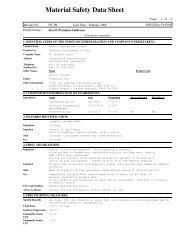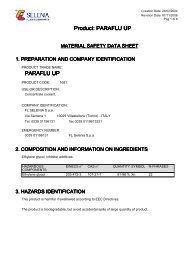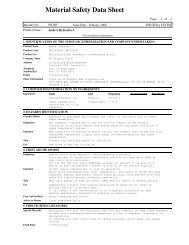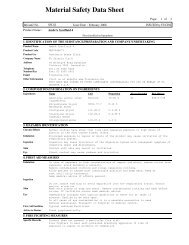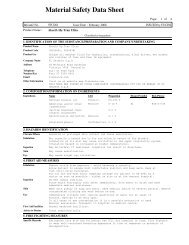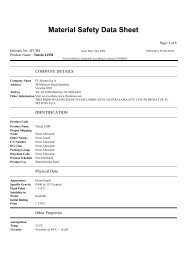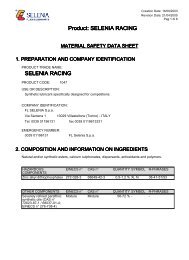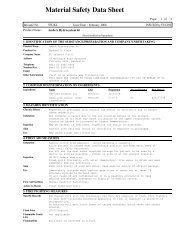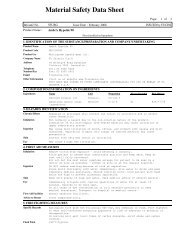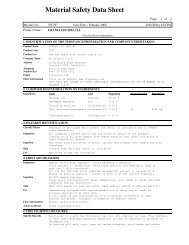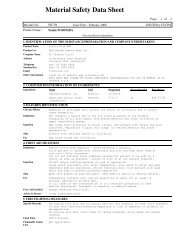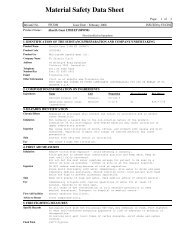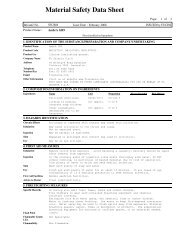Ambra VT Special - FL Selenia
Ambra VT Special - FL Selenia
Ambra VT Special - FL Selenia
- No tags were found...
Create successful ePaper yourself
Turn your PDF publications into a flip-book with our unique Google optimized e-Paper software.
Material Safety Data SheetPage: 1 ofInfosafe No. 5FUGL Issue Date : February 2008 ISSUED by FUCHSProduct Name :AmbrA <strong>VT</strong> <strong>Special</strong>Not classified as hazardous1. IDENTIFICATION OF THE SUBSTANCE/PREPARATION AND COMPANY/UNDERTAKINGProduct NameProduct UseCompany NameAddressTelephoneNumber/FaxEmailOther InformationAmbrA <strong>VT</strong> <strong>Special</strong>Supplied as specific oil for continuous variable transmission.<strong>FL</strong> <strong>Selenia</strong> S.p.A49 McIntyre Road SunshineVictoria 3020 AustraliaTel: 03 9300 6400Fax: 03 9300 6401flselenia.comVisit us at website www.flselenia.comTHIS MSDS WAS ISSUED BY FUCHS LUBRICANTS (AUSTRALASIA) PTY LTD ON BEHALF OF <strong>FL</strong>SELENIA S.p.A2. COMPOSITION/INFORMATION ON INGREDIENTSChemicalCharacterizationIngredientsOther InformationLiquid3. HAZARDS IDENTIFICATIONIrritancy of ProductChronic EffectsInhalationIngestionSkinEye4. FIRST AID MEASURESInhalationIngestionSkinEyeFirst Aid FacilitiesAdvice to Doctor5. FIRE FIGHTING MEASURESExtinguishing MediaName CAS Proportion Hazard Symbol Risk PhraseHighly refined paraffinic 64742-56-9oilsZinc alkyldithiophosphate 68649-42-360-100 %0-10 %Ingredients determined Mixture To 100%not to be hazardousThe petroleum oils in this product contain less than 3% DMSO extract as measuredby the IP 346 test method.Not classified as an irritant.Generally non-irritant on incidental contact. Excessive or prolonged contact maygive rise to irritant or dermatitic effects.Due to the low volatility of the product it is not expected to be an inhalationhazard. Inhalation of vapours generated at elevated temperatures, or of productmists may cause irritation to the nose and throat.No adverse effects expected however large amounts may cause nausea and vomiting.Repeated or prolonged skin contact may lead to irritation.May cause watering of eyes.Remove victim from exposure - avoid becoming a casualty. Allow patient to assumemost comfortable position and keep warm. Keep at rest until fully recovered. Seekmedical advice if effects persist. If breathing laboured and patient cyanotic(blue), ensure airways are clear and have qualified person give oxygen through aface mask. If breathing has stopped apply artificial respiration at once. In theevent of cardiac arrest, apply external cardiac massage.Give water to drink. DO NOT induce vomiting. Seek medical attention.Wash with plenty of soap and water. Seek medical advice if effects persist.Immediately irrigate with copious quantity of water for at least 15 minutes.Eyelids to be held open. In all cases of eye contamination it is a sensibleprecaution to seek medical advice.Normal washroom facilities are generally suitable. Ensure an eyewash station andsafety shower are available and ready for use.Treat symptomatically.Extinguish fire with the following: Use CO2, dry chemical or foam.5
Material Safety Data SheetPage: 2 ofInfosafe No. 5FUGL Issue Date : February 2008 ISSUED by FUCHSProduct Name :Specific HazardsHazardousCombustion ProductsPrecautions inconnection with FireFlash PointFlammable LimitsUELFlammable LimitsLELFlammabilityExplosion DataAmbrA <strong>VT</strong> <strong>Special</strong>Combustible.Not classified as hazardousCombustion products include oxides of carbon and other noxious smoke.Fire fighters to wear self-contained breathing apparatus if risk of exposure toproducts of decomposition.210 °C typicalApproximately 6% v/vApproximately 1.5% v/vCombustible liquid, will not burn unless preheated.Not considered an explosion risk under normal conditions of use6. ACCIDENTAL RELEASE MEASURESSpills & Disposal7. HANDLING AND STORAGECorrosivenessHandlingStoragePackagingSlippery when spilt. Avoid accidents, clean up immediately. Contain - preventcontamination of drains and waterways. CLEAN-UP METHODS - SMALL SPILLAGE (20L orless): Absorb or contain liquid with sand, earth or spill control material. Shovelup using non sparking tools and place in a labelled, sealable container forsubsequent safe disposal. Put leaking containers in a labelled drum or overdrum.Scrub contaminated surfaces with detergent solution. Retain washings ascontaminated waste.CLEAN-UP METHODS - LARGE SPILLAGE (more than 20L): Transfer to a labelled,sealable container for product recovery or safe disposal. Treat residues as forsmall spillage.Dispose according to local regulations.Not corrosiveWhen handling product in drums, safety footwear should be worn and proper handlingequipment should be used. Prevent spillages.Keep containers closed at all times. Store in cool place and out of directsunlight. Store away from oxidizing agents.Check containers regularly for leaks.No special packaging or labelling requirements.8. EXPOSURE CONTROLS/PERSONAL PROTECTIONNational ExposureStandardsOther ExposureInformationName STEL TWAHighly refined paraffinicoilsZinc alkyldithiophosphatemg/m3ppm mg/m3 ppm Footnote5 8 hour day- - - - --Exposure Standard means the average concentration of a particular substance in theworker's breathing zone, exposure to which, according to current knowledge, shouldnot cause adverse health effects nor cause undue discomfort to nearly all workers.It can be of three forms; time-weighted average (TWA), peak limitation, or shortterm exposure limit (STEL). Occupational exposure limits: When an exposurestandard has not been established by the National Occupational Health & SafetyCommission for a material, a blanket recommendation of 5 mg/m3 for respirablevapours, mists and dusts should be used.5RespiratoryProtectionEye ProtectionRespirator not normally required.Airborne concentrations should be kept to lowest levels possible. If vapour, mistor dust is generated and the occupational exposure limit of the product isexceeded, use appropriate AS/NZS 1715/1716 approved half-face filter respiratorsuitable for organic vapours or air supplied respirator after determining theairborne concentration of the contaminant. Air supplied respirators should alwaysbe worn when airborne concentration of the contaminant or oxygen content of theair is unknown.Safety glasses,goggles or faceshield as appropriate.
Material Safety Data SheetPage: 3 ofInfosafe No. 5FUGL Issue Date : February 2008 ISSUED by FUCHSProduct Name :Hand ProtectionFootwearBody ProtectionEng. ControlsHygiene MeasuresAmbrA <strong>VT</strong> <strong>Special</strong>Not classified as hazardousPVC, neoprene, or nitrile rubber gloves.Enclosed footwear.Overalls or similar protective apparel.Maintain concentration below recommended exposure limit. <strong>Special</strong> ventilation isnot normally required due to the low volatility of the product at normaltemperatures. However, in the operation of certain equipment or at elevatedtemperatures, mists or vapour may be generated and exhaust ventilation should beprovided to maintain airborne concentration levels below the exposure standard orwhere no exposure standard is allocated, as low as is reasonably practicable.Always wash hands before smoking, eating, drinking or using the toilet. Ifcontamination occurs, change clothing. Avoid carrying contaminated rags in pocketsor wearing soaked clothing. Discard internally contaminated gloves and footwear.Launder contaminated clothing before reuse.9. PHYSICAL AND CHEMICAL PROPERTIESAppearanceOdourViscous liquid.MildMelting Point Less than 0 °CBoiling Point Greater than 300 °CSolubility in WaterNot solubleSolubility in OrganicSolventsSoluble in petroleum solventsVapour Pressure Less than 0.1 mm Hg @ 25 °CVapour Density Greater than 2 (air=1)(Air=1)Viscosity 80cSt @ 40°C14.1cSt @ 100°CVolatile Component NoneDensityFlash PointFlammabilityFlammable LimitsLELFlammable LimitsUELExplosion Properties0.863 kg/L @ 15 °C typical210 °C typicalCombustible liquid, will not burn unless preheated.Approximately 1.5% v/vApproximately 6% v/vNot considered an explosion risk under normal conditions of useKinematic Viscosity Approximately 35 mm²/s @ 40 °COther Information10. STABILITY AND REACTIVITYStabilityHazardousPolymerizationMaterials to AvoidHazardousDecompositionProductsHazardous ReactionThese typical properties do not consitute a specificationStable under normal conditions of useWill not occurStrong oxidising agentsDecomposition products may include: a complex mixture of airborne solid and liquidparticulates and gases, such as carbon monoxide, carbon dioxide, soot, oxides ofnitrogen, and unidentified organic and inorganic compounds.Will react with strong oxidising agents.11. TOXICOLOGICAL INFORMATIONToxicologyInformationThis product contains petroleum base oils which may be refined by variousprocesses including severe solvent extraction, hydrocracking and hydrotreating.These oils have not been listed in the U.S. National Toxicology Program (NTP)Annual Report nor have they been classified by the International Agency forResearch on Cancer (IARC) as carcinogenic or probably carcinogenic5
Material Safety Data SheetPage: 4 ofInfosafe No. 5FUGL Issue Date : February 2008 ISSUED by FUCHSProduct Name :InhalationIngestionSkinEyeChronic EffectsAmbrA <strong>VT</strong> <strong>Special</strong>Not classified as hazardousto humans.Due to the low volatility of the product it is not expected to be an inhalationhazard. Inhalation of vapours generated at elevated temperatures, or of productmists may cause irritation to the nose and throat.No adverse effects expected however large amounts may cause nausea and vomiting.Repeated or prolonged skin contact may lead to irritation.May cause watering of eyes.12. ECOLOGICAL INFORMATIONEnviron. Protection13. DISPOSAL CONSIDERATIONS14. TRANSPORT INFORMATIONStorage andTransport15. REGULATORY INFORMATIONPoisons SchedulePackaging &LabellingGenerally non-irritant on incidental contact. Excessive or prolonged contact maygive rise to irritant or dermatitic effects.Do not allow material to enter drains or waterways.Not classified as a Dangerous Good according to the Australian Code for theTransport of Dangerous Goods by Road and Rail.Not classified as dangerous.Not Scheduled16. OTHER INFORMATIONNo special packaging or labelling requirements.Contact Person/Point Laboratory Manager (03) 9300 6400Research & Development Chemist (03) 9300 6400This information was prepared in good faith from the best information available atthe time of issue. It is based on the present level of research and to this extentwe believe it is accurate. However, no guarantee of accuracy is made or impliedand since conditions of use are beyond our control, all information relevant tousage is offered without warranty. The manufacturer will not be held responsiblefor any unauthorosed use of this information or for any modified or alteredversions.If you are an employer it is your duty to tell your employees, and any others thatmay be affected, of any hazards described in this sheet and of any precautionsthat should be taken.Material Safety Data Sheets are updated frequently. Please ensure you have acurrent copy.References * NOHSC:2011 National Code of Practice for the Preparation of Material Safety DataSheets* NOHSC:1008 Approved Criteria for Classifying Hazardous Substances* NOHSC:10005 List of Designated Hazardous Substances* NOHSC:1005 Control of Workplace Hazardous Substances, National Model Regulations* NOHSC:2007 Control of Workplace Hazardous Substances, National Code of Practice* NOHSC:1003 Exposure Standards for Atmospheric Contaminants in the OccupationalEnvironment, National Exposure Standards* NOHSC:3008 Exposure Standards for Atmospheric Contaminants in the OccupationalEnvironment, Guidance Note* NOHSC:1015 Storage and Handling of Workplace Dangerous Goods, National Standard* NOHSC:2017 Storage and Handling of Workplace Dangerous Goods, National Code ofPractice* SUSDP, Standard for the Uniform Scheduling of Drugs and Poisons* ADG, Australian Dangerous Goods Code* MSDS of component materials5Last Change Supersedes issue date: Sept 2004.Reason/s for revision: Alignment to NOHSC requirements.
Material Safety Data SheetPage: 5 ofInfosafe No. 5FUGL Issue Date : February 2008 ISSUED by FUCHSProduct Name :Poisons ScheduleAmbrA <strong>VT</strong> <strong>Special</strong>Not Scheduled...End Of MSDS...Not classified as hazardous5



